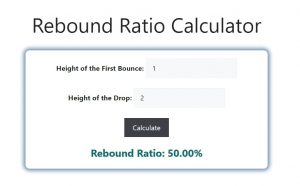About Rebound Ratio Calculator (Formula)
The rebound ratio is an important measurement in various fields, including sports, physics, and material science. It helps determine the efficiency of a bounce, which can be crucial for evaluating the performance of balls, toys, and other objects that undergo elastic collisions. The Rebound Ratio Calculator allows you to quantify how much of the initial drop height is recovered during the bounce. This article explains how to use the calculator effectively, along with examples and frequently asked questions.
Formula
The formula for calculating the rebound ratio is:
Rebound Ratio = (Height of the First Bounce / Height of the Drop) * 100
This formula provides a percentage that reflects the height achieved on the first bounce compared to the height from which the object was dropped.
How to Use
Using the Rebound Ratio Calculator is straightforward:
- Measure the Drop Height: Determine the height from which the object is dropped.
- Measure the Rebound Height: Record the height reached by the object after its first bounce.
- Apply the Formula: Insert your measurements into the formula to calculate the rebound ratio.
- Analyze the Results: The result will indicate the efficiency of the bounce as a percentage.
Example
Suppose a basketball is dropped from a height of 2 meters and bounces back up to a height of 1 meter.
Using the formula:
Rebound Ratio = (1 meter / 2 meters) * 100 = 50%
In this example, the rebound ratio is 50%, indicating that the basketball returns half of its original drop height on the first bounce.

FAQs
- What is the rebound ratio?
The rebound ratio measures the efficiency of a bounce, comparing the height of the first bounce to the initial drop height. - Why is the rebound ratio important?
It helps assess the performance of sports equipment, toys, and materials in terms of energy conservation during a bounce. - How is the rebound ratio expressed?
The rebound ratio is expressed as a percentage, indicating the proportion of the original height achieved after the bounce. - What factors can affect the rebound ratio?
Factors include the material properties, the shape of the object, and the surface onto which it is dropped. - Can the rebound ratio be greater than 100%?
No, a rebound ratio above 100% is not possible, as it would indicate that the object is bouncing higher than the height from which it was dropped. - How can I improve the rebound ratio of a ball?
Improving the material and design of the ball can enhance its elasticity and rebound capabilities. - What applications use the rebound ratio?
The rebound ratio is commonly used in sports equipment testing, material science, and product development. - How can I measure the height of the first bounce accurately?
Use a measuring tape or a marked wall to measure the maximum height reached after the bounce. - Is the rebound ratio the same for all objects?
No, different objects will have varying rebound ratios based on their materials and design. - How do I calculate the rebound ratio for multiple bounces?
For multiple bounces, calculate the rebound ratio for each bounce separately and compare the results. - What materials have the highest rebound ratios?
Materials like rubber typically have higher rebound ratios due to their elastic properties. - Does temperature affect the rebound ratio?
Yes, temperature can impact the elasticity of materials, potentially affecting the rebound ratio. - What is an ideal rebound ratio for sports balls?
An ideal rebound ratio for sports balls varies by sport, but generally, it should be between 60% to 90%. - Can the rebound ratio help in product design?
Yes, understanding the rebound ratio can guide design improvements to enhance product performance. - How often should I measure the rebound ratio for quality control?
Regular testing during production and after wear can help ensure consistent quality. - What is the relationship between weight and rebound ratio?
Heavier objects may have lower rebound ratios due to energy loss during the impact. - How does surface type affect the rebound ratio?
Different surfaces (e.g., concrete, grass, wood) can absorb varying amounts of energy, affecting the rebound height. - Can I use a smartphone app to measure rebound height?
Yes, some smartphone apps utilize motion sensors to measure bounce heights, although accuracy may vary. - What equipment is needed to conduct rebound ratio tests?
Basic equipment includes a measuring tape, a stopwatch, and potentially a high-speed camera for analysis. - How does the angle of the drop affect the rebound ratio?
A vertical drop generally yields the most consistent rebound ratio, while angled drops can alter the trajectory and height of the bounce.
Conclusion
The Rebound Ratio Calculator is a valuable tool for understanding the efficiency of bounces in various applications. By measuring the rebound height relative to the drop height, individuals and businesses can gain insights into product performance, optimize designs, and ensure quality in manufacturing. Regularly assessing the rebound ratio can lead to significant improvements in the functionality of sports equipment, toys, and materials.